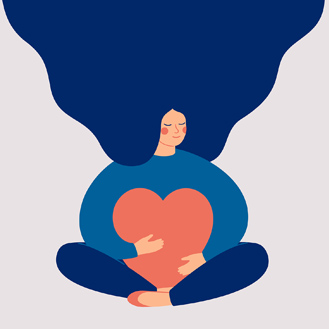
This article includes discussion of mental health that may be challenging for some readers.
February 12, 2025
By Neiki Rokni, MD Program Student, Drexel University College of Medicine
In today’s digital age, social media has become a central aspect of adolescent girls’ lives. Platforms like Instagram, TikTok and Snapchat are among the most popular, offering spaces to connect with friends, share content and explore interests. While social media offers many benefits, including connection, self-expression and entertainment, it can also negatively impact mental health, particularly within this demographic, contributing to body dissatisfaction, disordered eating patterns, and increased anxiety and depression symptoms (Casares & Binkley, 2021).
Th
While social media can be a source of empowerment for adolescent girls, it can also be problematic for their mental health. Regular engagement on TikTok and Instagram exposes girls to curated images that promote unrealistic beauty standards. The constant emphasis on appearance-based content on these highly visual platforms often leads girls to internalize these standards, increasing their risk for negative self-perception and self-objectification.
Studies show that many girls feel pressured to edit their photos, altering their appearance to fit the idealized beauty they see online (Kleemans et al., 2016). Unfortunately, editing photos and using filters have been linked to increased body dissatisfaction and a desire to undergo cosmetic procedures to resemble filtered images (Chen et al., 2019). Additionally, exposure to content that emphasizes thinness has been linked to disordered eating behaviors, like skipping meals, binge eating and following extreme diets (Wilksch et al., 2020). These harmful patterns are reinforced by influencers and viral trends like “What I Eat in a Day,” which may unintentionally push girls to engage in unhealthy eating behaviors.
德
Drexel's Employee Assistance Program is available to help employees in need of support through confidential, 24/7 counseling at 888.628.4824. This is offered at no cost to benefits-eligible faculty and professional staff, their family members, and Drexel graduate students. More information is available on the Human Resources website. Students can reach out for support via Student Wellbeing.
Sources/Resources:
- Burnette, C. B., Kwitowski, M. A., & Mazzeo, S. E. (2017). "I don't need people to tell me I'm pretty on social media:" A qualitative study of social media and body image in early adolescent girls. Body Image, 23, 114–125. https://doi.org/10.1016/j.bodyim.2017.09.001
- Casares, D. R., & Binkley, E. E. (2021). An unfiltered look at idealized images: A social media intervention for adolescent girls. Journal of Creativity in Mental Health, 17(3), 313–331. https://doi.org/10.1080/15401383.2021.1892556
- Chen, J., Ishii, M., Bater, K. L., Darrach, H., Liao, D., Huynh, P. P., Reh, I. P., Nellis, J. C., Kumar, A. R., & Ishii, L. E. (2019). Association between the use of social media and photograph editing applications, self-esteem, and cosmetic surgery acceptance. JAMA Facial Plastic Surgery, 21(5), 361–367. https://doi.org/10.1001/jamafacial.2019.0328
- Fardouly, J., Magson, N. R., Johnco, C. J., Oar, E. L., & Rapee, R. M. (2018). Parental control of the time preadolescents spend on social media: Links with preadolescents' social media appearance comparisons and mental health. Journal of Youth and Adolescence, 47(7), 1456–1468. https://doi.org/10.1007/s10964-018-0870-1
- Gordon, C. S., Jarman, H. K., Rodgers, R. F., McLean, S. A., Slater, A., Fuller-Tyszkiewicz, M., & Paxton, S. J. (2021). Outcomes of a cluster randomized controlled trial of the SoMe social media literacy program for improving body image-related outcomes in adolescent boys and girls. Nutrients, 13(11), 3825. https://doi.org/10.3390/nu13113825
- Kleemans, M., Daalmans, S., Carbaat, I., & Anschütz, D. (2016). Picture perfect: The direct effect of manipulated Instagram photos on body image in adolescent girls. Media Psychology, 21(1), 93–110. https://doi.org/10.1080/15213269.2016.1257392
- Pouwels, J. L., Valkenburg, P. M., Beyens, I., van Driel, I. I., & Keijsers, L. (2021). Social media use and friendship closeness in adolescents' daily lives: An experience sampling study. Developmental Psychology, 57(2), 309–323. https://doi.org/10.1037/dev0001148
- Wilksch, S. M., O'Shea, A., Ho, P., Byrne, S., & Wade, T. D. (2020). The relationship between social media use and disordered eating in young adolescents. International Journal of Eating Disorders, 53, 96–106. https://doi.org/10.1002/eat.23198
- Yue, Z., & Rich, M. (2023). Social media and adolescent mental health. Current Pediatrics Reports, 11, 157–166. https://doi.org/10.1007/s40124-023-00298-z